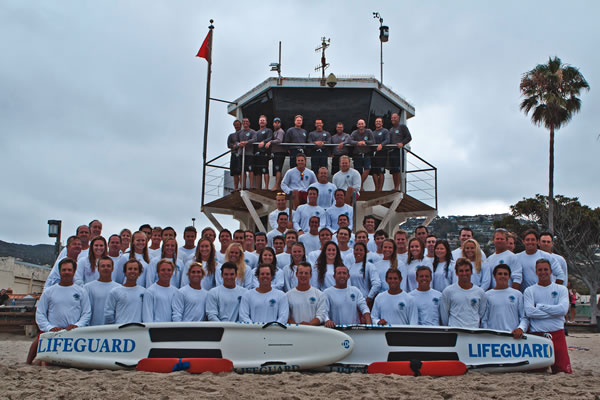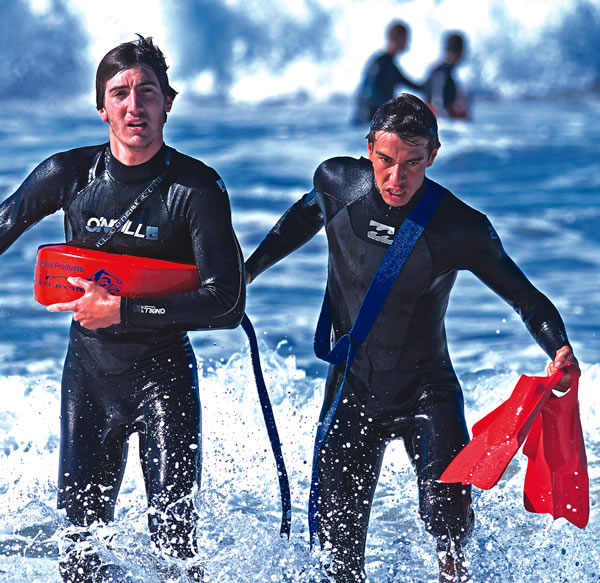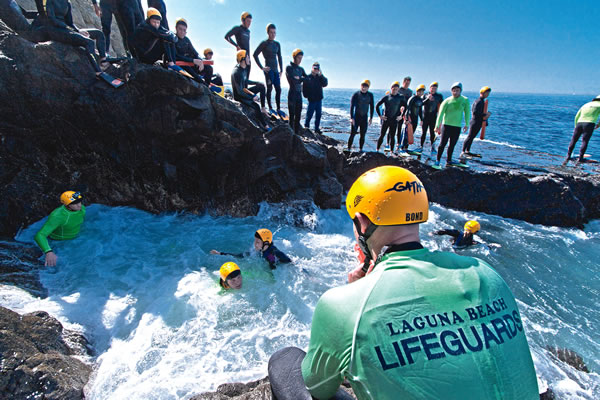For decades, Laguna’s lifeguards have stood sentry, prepared for anything and everything that may happen across the coastline.
By Alli Tong | Photos by Mitch Ridder
Each year at the end of February, 50 or more aspiring lifeguards will plunge into Laguna Beach’s chilly ocean waters—temperatures that often dip into the frigid 50s—near the Main Beach buoy in the early morning. In these uncomfortable conditions, they overcome a 1,000-meter swim in under 20 minutes as part of the annual Laguna Beach lifeguard tryouts.
This is just one important test that these hopeful lifeguards, who often range in age from 16 to mid-40s, must pass in order to make it into the Seasonal and Rookie Ocean Lifeguard Academy (SROLA), a United States Lifesaving Association (USLA) certified training. They will undergo intense, rigorous training encompassing more than 100 hours, and only upon completion of training will a select group be given the prestigious honor of becoming a cadet, or rookie guard.
However, only half of those that show up on tryout day are invited to the SROLA, and even those who make it to rookie training aren’t guaranteed hire. The marine safety department currently employs seven full-time guards and around 100 seasonal guards, many of them being students during the off-season. Vacancies are hard to come by—typically, there are 15 to 20 new spots open each year. Furthermore, of those that do make SROLA, many will willingly drop out, unprepared, or perhaps unknowing, of the intense physical and mental dedication it takes to be a lifeguard in Laguna. Others will be let go due to their lack of physical endurance or mental awareness. Unlike most other Orange County marine safety departments, Laguna Beach’s department has cadets go through two consecutive years of rookie training before they may advance to a higher ranking, such as ocean lifeguard I, II or III.
“Our training is considered one of the most difficult in Southern California, and it needs to be,” says Tom Trager, marine safety captain. “Once fully trained, our guards are scheduled to work a beach that is typically an isolated cove with no immediate backup or help. Unlike other beaches in Southern California, we don’t have long stretches of sand where the towers are all able to watch one another.”
Annually the department of marine safety averages more than 3,000 rescues, 180 major medical aids and 3,800 minor medical aids; and while the lifeguard staff of approximately 100 would humbly prefer not to be named as the “unsung heroes of the ocean,” they certainly are to the more than 4 million visitors that grace the city’s 5.5-mile stretch of beaches every summer. Because of this, the department has to implement a training program that is one of the most intense, rigorous experiences that trainees will encounter. The department’s motto: Expect the unexpected.
Porter Hogan, 21, who has been a Laguna Beach lifeguard for six years and tried out at age 16, recalls his training days as painstakingly difficult, however, he realizes why it’s a hard-hitting program.
“It needs to be tough. … Several times I’ve wanted to drop myself—it’s brutal,” Porter says earnestly. “[But] it needs to be brutal. The lifeguard department can only take the best of the best. In the summer you need to be able to handle everything. If people can’t handle it now, they won’t be able to handle it in the summer, where they’re constantly making rescues in 60-degree water.”
Focus on Training
Typically training follows about one month after tryouts, around the end of March, for four to five consecutive weekends, totaling 100 hours. Those who are invited back for the first day of training will begin their day around 8 a.m. on a Saturday, where they will line up in alphabetical order in Speedos and swimsuits, and dive into the 50-degree ocean waters to begin a mile-long swim.
After this endeavor, there’s no rest for the weary. Trainees, who often have no experience lifeguarding or with medical training, will have to complete a written test, and upon completion, go straight into rescue drills, where they’ll be thrust into different types of scenarios and conditions to test how they react under pressure. After that it’s another long swim, sprint, and then what the lifeguards call “practicals” at the City Council Chambers. These important tests grade each trainee further on various circumstances, from an infant needing CPR to controlling bleeding, which they are taught how to handle during training. But trainees aren’t only scored on how well they react; they’re also graded on their abilities to follow direction and overall attitude. Every missed question counts against the cadets, who strive for the least number of points, similar to golf. After practicals, trainees must endure another event, such as swimming or sprinting, before they’re let go for the day—and do it all again the next day.
Yet all the sprinting, running, studying and bearing frigid waters isn’t for nothing. In fact, according to data recorded from the USLA, between 1964 and 2011, only 10 drowning deaths have occurred at guarded beaches in Laguna and, according to USLA, only one in 18 million people will drown while attending a beach protected by lifeguards.
But for Porter, that “one” came all to close one day while guarding Treasure Island. Porter says that a child, who was about 5 years old, was pulled under by a rift, a common occurrence at Treasure Island where the surf can become large with numerous rip currents forming at the north end along the rocks and at the southern end. Fortunately, Porter swiftly came to the little girl’s aid and pulled her out safely, but he adds that if it weren’t for his extensive training, it might have been a different outcome.
“When I’m working out, doing sprints, I think about her to push myself … because if I wasn’t as fast as I was sprinting and swimming, I might not have not got to her in time,” Porter says. “The training, especially with the practicals, they want you to expect anything. One day it might be a nice day and the next thing you know someone could fall off a cliff—that happened to me a couple years ago when I was sitting at Goff [Cove beach].”
Expecting the Unexpected
Kai Bond, a marine safety lieutenant who grew up in Laguna and has been a lifeguard for the city for 18 years, oversees the training program as well as procedures and coordinating lifeguard work schedules, among other duties that range from motivating guards to fitness training. Kai’s years as a veteran guard has taught him that, sometimes, even when everything is done right, some things can’t be changed.
“The most challenging thing I’ve ever come across is tragedy … when you do everything that you can possibly do and still end up with a negative result,” he says.
But through these challenges on the beach comes the realization of the importance of training, which is why it is so labor intensive. Guards must be prepared at all times for the unforeseen—and even the unimaginable.
Dale Ghere, a retiree who has lived in Laguna since 1960, guarded at St. Ann’s Beach from 1960 to 1974. Dale is also credited with helping to develop the first rookie training program in the 1960s, and remembers one day particularly well. He was guarding at Crescent Bay—the day started out calm, but any good guard knows that this only means you need to be especially watchful.
“A few of the kids that I knew gathered around the tower, and we enjoyed telling each other stories,” he recalls. “Then someone yelled, ‘Look!’ and pointed toward the cliff at the north end of the beach.”
Dale knew to watch the waters, but not so much the cliffs. There, a young boy clung to the face of the cliff a few feet below the top, but because of an overhang, he was stuck. Dale recalls that it was clear at first glace that if this boy fell, he would die. So, he yelled to the child to stay calm and quickly ran for backup. Dale and another guard, Dean Westgaard, first decided to throw a rope made of parachute cord down to the boy but quickly ran into problems, as they knew the boy couldn’t grab hold of the rope without falling.
The next idea was to tie the rope around Dale’s chest. He would stand at the bottom of the cliff and be pulled up, grabbing the boy on his way. This also failed, as Dale started slipping through the rope. Dale quickly had another idea: He would strap himself into his rescue tube and fasten the rope to the brass ring around the tube, which provided the needed support to hold his weight. It worked perfectly; as Dale was pulled up, he carried the boy up with him to safety.
But as Dale reached the top, reality sunk in as to what could have happened to both of them, and his knees went weak. The brass ring that was supporting his weight had come apart, and the only thing keeping the rope to the ring was a small fragment of the metal, which had dug into the rope.
“Dean asked if I was OK, and I said yes and then showed him the rope,” Dale says. “Neither of us said anything, but we both knew what the other was thinking. Today, we were just lucky.”
Nowadays, in part due to Laguna’s rocky coastal terrain and more visitors to the beaches each year, cliff rescues play a large role in the rookie program with training that teaches cadets how to handle rescue victims around rocks while anticipating wave surges and currents.
“The training today is way different and way more difficult and complicated—you know in the ’50s the guard just showed up, grabbed his beach umbrella and sat in the sand,” Dale says. “Today it’s like running a college course and paramedic program.”
Allison McCormick, a Corona del Mar High School senior, has been a Laguna lifeguard for three years and is now an ocean lifeguard I. She was top cadet in 2012, which means that she scored the best (or the least number of points) during rookie training last year. Allison says that, for her, the extensive knowledge given during training on how to handle specific situations is what helped her one day last summer while running relief for tower guards in south Laguna. Two kids were in distress, and Allison had to quickly take action.
“[The training] helped me to accomplish two things at once,” she says, adding that they’re taught to go to the individual who is in need of more help first and assist him or her to a buoy before going to the other.
While the SROLA is a challenging experience for most, it’s one that clearly needs to be—millions of people’s lives are in their hands each and every day. For those that eventually do make it through training and are awarded a coveted spot in the department of marine safety, they’re proud to serve the beaches of Laguna. “People work very hard to stay in their position and take it seriously,” Porter says. “For me, why I’m so passionate about [lifeguarding] is helping others.”
From bleeding to cliff rescues, obstructed airways and broken limbs, Laguna’s lifeguards are prepared to handle every situation that comes their way. Although often not in plain sight on a busy summer day, these watchful ocean guardians are there, anticipating anything and everything.
“I learn that every day is different and brings new challenges,” Kai says. “What we do, I do, makes a difference. And that’s a good thing; as a lifeguard in Laguna Beach, we have the respect and support of the community, and I feel very fortunate to be in this position.” LBM







